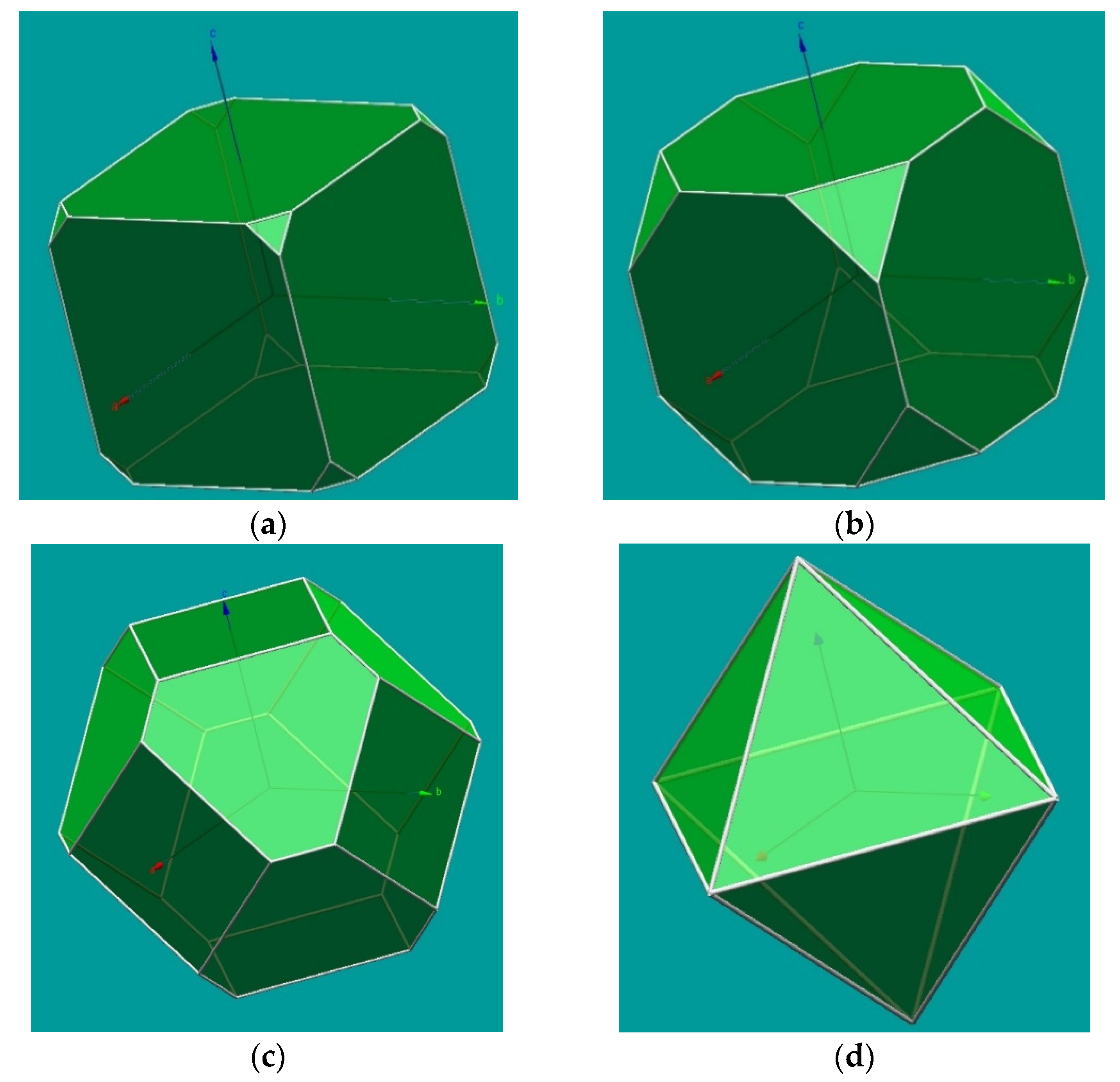Virtual Models for Crystallography Teaching in Mineralogy: Some Suggestions †
Abstract
:1. Introduction
2. Materials and Methods
3. Examples and Discussion
3.1. Models of Crystal Structures
3.2. Models of External Morphologies (Crystal Forms and Twinning)
4. Conclusions
Author Contributions
Institutional Review Board Statement
Informed Consent Statement
Data Availability Statement
Acknowledgments
Conflicts of Interest
References
- Rakovan, J. Computer Programs for Drawing Crystal Shapes and Atomic Structures. Rocks Miner. 2018, 93, 60–64. [Google Scholar] [CrossRef]
- Weber, S. KrystalShaper—Crystal Morphology Editor/Viewer. JCrystalSoft. Available online: http://www.jcrystal.com/products/krystalshaper/index.htm (accessed on 12 June 2020).
- Kraus, W.; Nolze, G. PowderCell 2.3—Powder Pattern Calculation from Single Crystal Data and Refinement of Experimental Curves. Available online: http://www.ccp14.ac.uk/ccp/web-mirrors/powdcell/a_v/v_1/powder/e_cell.html (accessed on 12 June 2020).
- Momma, K.; Izumi, F. VESTA 3 for three-dimensional visualization of crystal, volumetric and morphology data. J. Appl. Crystallogr. 2011, 44, 1272–1276. Available online: https://jp-minerals.org/vesta/en/ (accessed on 12 June 2020). [CrossRef]
- Kaminsky, W. WinXMorph: A computer program to draw crystal morphology, growth sectors and cross sections with export files in VRML V2.0 utf8-virtual reality format. J. Appl. Crystallogr. 2005, 38, 566–567. Available online: http://cad4.cpac.washington.edu/WinXMorphHome/WinXMorph.htm (accessed on 12 June 2020). [CrossRef]
- Kaminsky, W. From CIF to virtual morphology using the WinXMorph program. J. Appl. Crystallogr. 2007, 40, 382–385. [Google Scholar] [CrossRef]
- Downs, R.T.; Hall-Wallace, M. The American Mineralogist crystal structure database. Am. Mineral. 2003, 88, 247–250. Available online: http://rruff.geo.arizona.edu/AMS/amcsd.php (accessed on 12 June 2020).
- Available online: http://rruff.geo.arizona.edu/AMS/download.php?id=00802.amc&down=amc (accessed on 12 June 2020).
- Available online: http://rruff.geo.arizona.edu/AMS/AMC_text_files/18664_amc.txt (accessed on 12 June 2020).


Publisher’s Note: MDPI stays neutral with regard to jurisdictional claims in published maps and institutional affiliations. |
© 2020 by the authors. Licensee MDPI, Basel, Switzerland. This article is an open access article distributed under the terms and conditions of the Creative Commons Attribution (CC BY) license (https://creativecommons.org/licenses/by/4.0/).
Share and Cite
Alves, C.; Figueiredo, C.; Sanjurjo-Sánchez, J. Virtual Models for Crystallography Teaching in Mineralogy: Some Suggestions. Environ. Sci. Proc. 2021, 5, 10. https://doi.org/10.3390/IECG2020-08738
Alves C, Figueiredo C, Sanjurjo-Sánchez J. Virtual Models for Crystallography Teaching in Mineralogy: Some Suggestions. Environmental Sciences Proceedings. 2021; 5(1):10. https://doi.org/10.3390/IECG2020-08738
Chicago/Turabian StyleAlves, Carlos, Carlos Figueiredo, and Jorge Sanjurjo-Sánchez. 2021. "Virtual Models for Crystallography Teaching in Mineralogy: Some Suggestions" Environmental Sciences Proceedings 5, no. 1: 10. https://doi.org/10.3390/IECG2020-08738
APA StyleAlves, C., Figueiredo, C., & Sanjurjo-Sánchez, J. (2021). Virtual Models for Crystallography Teaching in Mineralogy: Some Suggestions. Environmental Sciences Proceedings, 5(1), 10. https://doi.org/10.3390/IECG2020-08738







